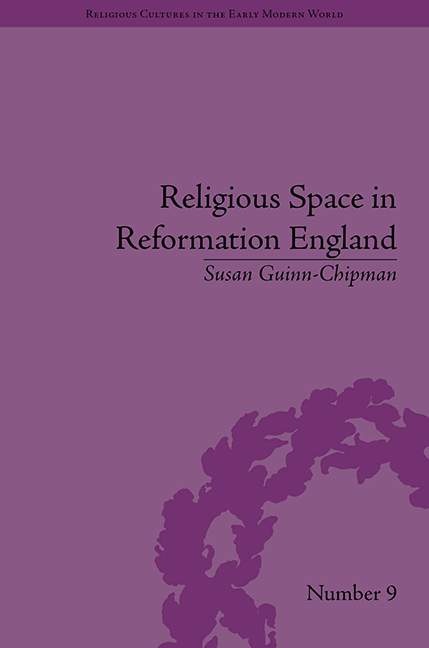Book contents
- Frontmatter
- CONTENTS
- Acknowledgements
- List of Figures
- Introduction
- 1 Dissolution and Adaptation: Religious Space in Henrician England
- 2 Radicalization and Response: Religious Space in Late Henrician and Edwardian England
- 3 Reframing the Parish Church in Marian and Elizabethan England: Cultural Adaptation in the Later Sixteenth Century
- 4 Contesting Religious Space: Alteration and Reaction in Stuart England
- Epilogue: The Persistence of Memory in Early Modern England: Mapping the Past
- Notes
- Works Cited
- Index
Epilogue: The Persistence of Memory in Early Modern England: Mapping the Past
- Frontmatter
- CONTENTS
- Acknowledgements
- List of Figures
- Introduction
- 1 Dissolution and Adaptation: Religious Space in Henrician England
- 2 Radicalization and Response: Religious Space in Late Henrician and Edwardian England
- 3 Reframing the Parish Church in Marian and Elizabethan England: Cultural Adaptation in the Later Sixteenth Century
- 4 Contesting Religious Space: Alteration and Reaction in Stuart England
- Epilogue: The Persistence of Memory in Early Modern England: Mapping the Past
- Notes
- Works Cited
- Index
Summary
Recurring encounters with places of memory, Pierre Nora's lieux de memoire, were not uncommon in early modern England. Following two decades of war and Interregnum, memories of where the altar and the ‘rood loft Auntiently’ once stood in the old parson's chancel voiced by parishioners such as the aged John Holliehead of Wigan persisted. Encounters with such places of memory together with engagement in doctrinal debate as to their orthodoxy over the course of the sixteenth and early seventeenth centuries inhibited what Keith Thomas termed ‘instant amnesia’. Affinity for the local spaces of the pre-suppression past informed by the everyday encounters and conflicts of parishioners, churchwardens and clergy also found expression in the scholarship of antiquarians. Works by generations of the Randle Holmes of Chester and scholars surrounding John Aubrey of Wiltshire preserved and, particularly amid seventeenth-century disruptions and post-war nostalgia, historicized topographies of parish church and landscape marked by still extant pre-Reformation remains. Their efforts reflect a nexus of local, micro-level spatial identities and broader antiquarian concerns aimed at composing biographies of place. Patterns of cultural adaptation among this elite were characterized by an interplay of topographically informed spatial identities, long-deferred scholarly critique of the loss of the material past and the formation of intellectual memory. Archaeologically rooted in the ancient and medieval past and increasingly scientifically informed, this intellectualization played a critical role in the formation of a historicized pre-suppression past and the construction of broader regional and national identities.
- Type
- Chapter
- Information
- Religious Space in Reformation EnglandContesting the Past, pp. 123 - 134Publisher: Pickering & ChattoFirst published in: 2014



